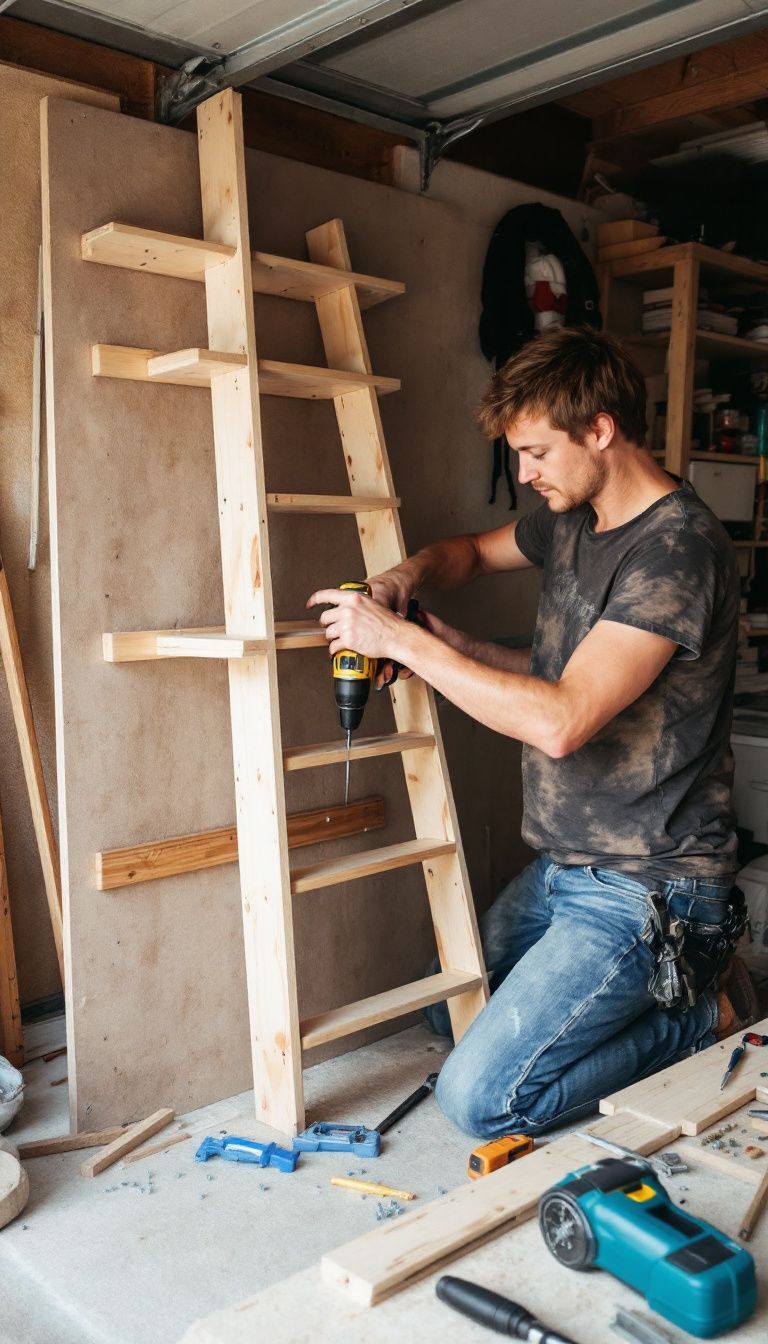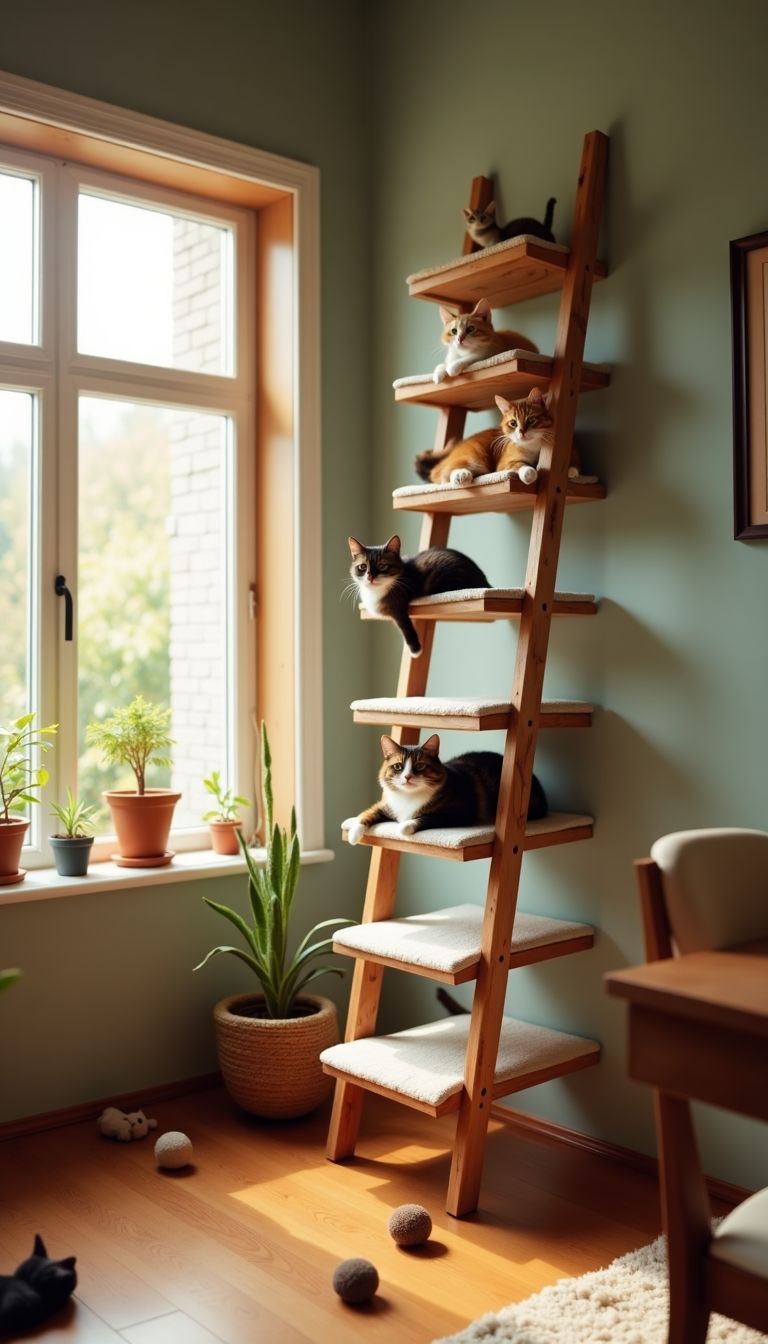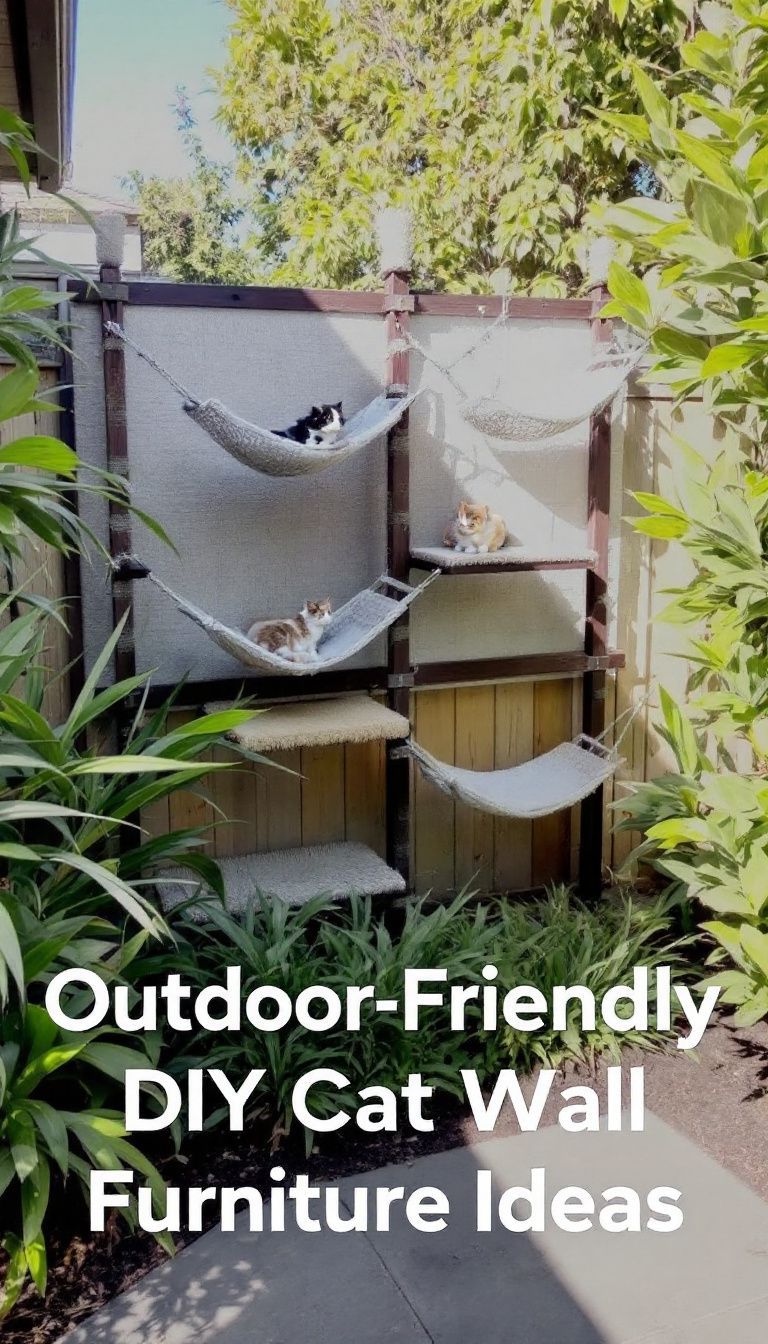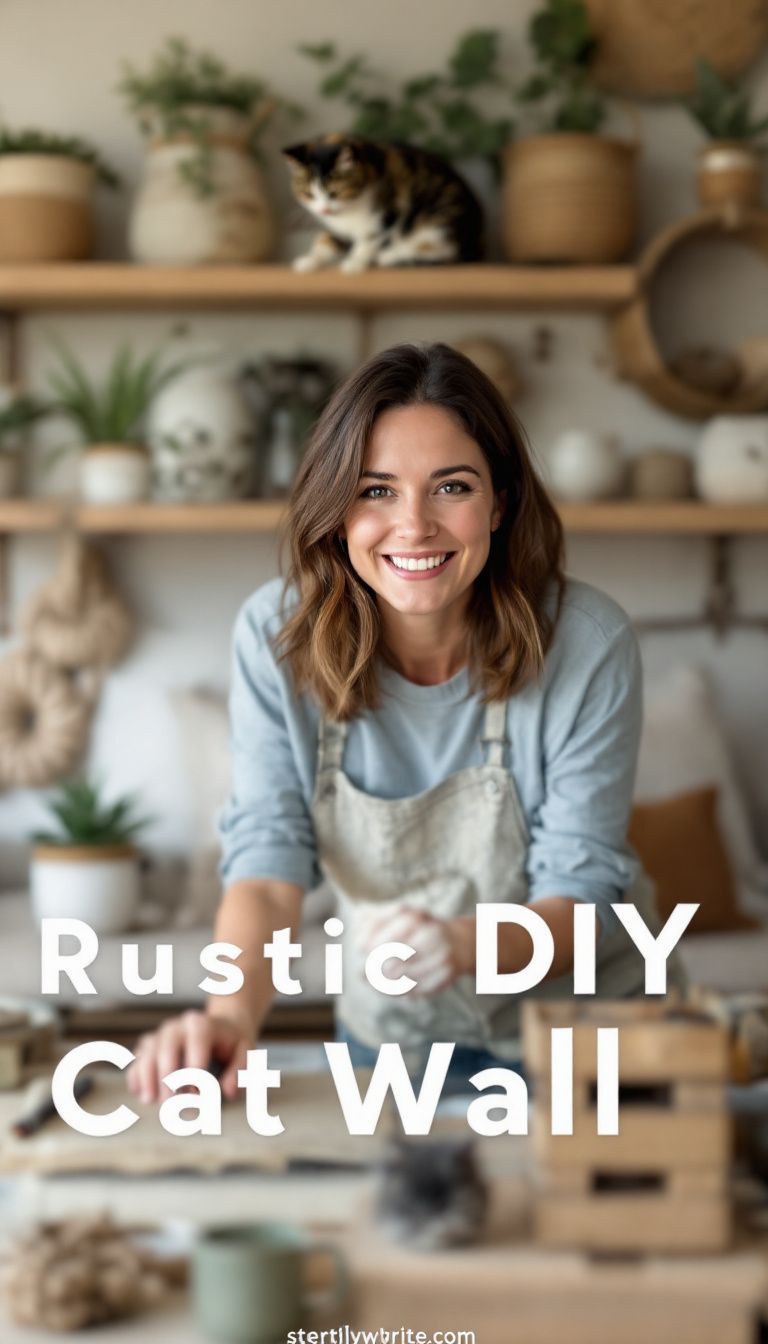If your cats are anything like mine, they try to climb everything but their own cat tree. My three British Shorthairs are always looking for new adventures in our cozy living room that's not much bigger than a shoebox.
Big, bulky cat furniture just wasn't working out. That's when I stumbled upon the perfect fix: a DIY cat wall ladder. It's a space saver and total fun zone for the kitties. This guide is all about helping you create an awesome climbing wall at home without needing a lot of space or fancy equipment.
Let’s make our furry pals happy!
Key Takeaways
- You need basic materials like wood planks, screws, and a sisal rug to build your cat wall ladder. Tools like a drill, saw, and screwdriver are also necessary.
- Plan your ladder by measuring space and thinking about your cat's safety. Put the platforms 14 inches off the ground and keep them 12-18 inches apart.
- When building, start with a strong base then add steps for climbing. Make sure everything is secure on the wall so cats can climb safely.
- Add fun features like hammocks or rope bridges to make climbing more exciting. Choose colors that match your room decor.
- Check the ladder regularly for any loose parts or wear and tear to keep it safe for cats to use.

Essential Materials and Tools

For your DIY cat wall ladder, you'll need some basic stuff like wood planks, screws, and brackets. You'll also use tools such as a drill, saw, and screwdriver to put everything together.
List of materials needed

I'm setting out to build a DIY cat wall ladder. This project will make my cat happy and fit. Here's what I need:
- One IKEA sisal rug, like VISTOFT or VOKSLEV, since OSTED is no longer sold. These rugs give cats something to scratch and climb on.
- A minimum of eight screw hooks for hanging the ladder securely.
- Sturdy wire to connect everything together.
- Two EKBY LERBERG brackets or something similar, such as RAMSHULT, for supporting the shelf.
- One solid wood shelf for a resting spot at the top.
- Two BORRIS doormats (KRISTRUP works too) for added texture and grip on steps.
- Screws for mounting everything firmly to the wall.
With these items, I can start building a fun climbing solution for my cat that also looks good in my home.
Overview of tools required

To build a cat wall ladder, I need some important tools. Having the right tools makes the job safer and easier.
- Stud Finder: This helps find the wooden beams in my wall. It ensures that the ladder is secure.
- Electric Drill: I use this to make holes and drive screws into the wood easily. It saves time and effort.
- Screwdriver/Drill: A manual screwdriver works fine, but a drill saves even more time. I can switch between both for different tasks.
- Wood Saw: This is needed for cutting wood to size. A hand saw will work, but a power saw makes cuts quicker.
- Paint Brushes: After building, I paint or finish the wood with these brushes. They help make it look nice and protect it too.
- Digital Detector: This tool checks for pipes or wires inside my walls before I drill any holes. It's crucial for safety.
These tools make sure that the cat wall ladder is stable and fun for my furry friend!
Planning Your Cat Wall Ladder

When planning your cat wall ladder, start by measuring your space. Think about where to place it for the best use and fun for your cat.
Measuring and space assessment

I assess the space before building. My living room is 35m², so I think about how much wall area I can use. Vertical space is key for my cat's happiness. Measuring helps me see where to place the ladder.
Using a stud finder is crucial. It shows where the wall studs are located. These points will support my cat wall ladder safely. No need for detailed measurements; just enjoy the process of creating and have fun with it!
Design tips for maximizing cat enjoyment and safety
Starting the wall-mounted platforms 14 inches off the ground helps keep my cats safe. They can easily reach them without jumping too high. It's smart to maintain a distance of 12-18 inches between each step.
This spacing works well for different sizes and fitness levels of cats.
For my active cats, I add scratching poles or sprinting routes near the ladder. These options give them space to play and exercise. Timid cats benefit from hiding spots on or around the ladder.
It provides them comfort and security when they need it most.
I always think about how to make their climbing experience fun and safe at the same time. Choosing sturdy materials is key, as it keeps everything secure on the wall… Plus, nice touches in color or style help blend into my room decor while making cat-friendly spaces that they will love!
Step-by-Step Construction Guide

Building a cat wall ladder is easy and fun. Start with the base structure, then add steps for your cat to climb.
Building the base structure
I start with the base structure for my cat wall ladder. I find a sturdy rug that fits between the floor and ceiling. This rug gets attached to a wooden plinth in the ceiling. It helps keep everything stable.
Next, I use a stud finder to hang it securely. The shelf carriers must be aligned well. I make sure they are strong enough for my cat's weight. Once that's done, I can move on to adding steps and platforms for climbing fun….
Adding steps and platforms
Adding steps and platforms is easy. Each step should be 7 cm x 4 cm spruce wood for strength. I make them 26 cm deep, and with oak wood on the front and back, they extend to 30 cm.
This gives my cats a comfy spot to rest as they climb.
I secure each step using four screws that fit in their 9.5 cm x 9.5 cm width. The whole setup can hold up to 25 kg, perfect for one or two large cats. It’s smart to plan enough space between steps so my kitties feel safe while climbing!
Securing the ladder to the wall
Once I've added the steps and platforms, it’s time to secure the ladder to the wall. I position it carefully where I want it attached. A strong screw is key here. I add a screw through the front of the climber into the stud at 1–2′ intervals.
This ensures my kitty can climb safely.
The structure must be firmly secured. It needs to hold my cat's weight as they play and explore. Choosing screws based on my wall material is important too. For softer walls like drywall, special anchors may help keep everything sturdy—this way, my little furball has fun without worries!
Customization Options

Add some fun touches to your cat wall ladder. Consider hammocks for lounging or rope bridges for extra play. Each feature can make the climb even more exciting. You’ll also want to think about colors and styles that match your room…
It’s a great way to blend function with decor!
Ideas for fun additions like hammocks and rope bridges
Adding fun features to the cat wall ladder can make it even more exciting for your cat. Here are some great ideas to consider:
- Hammocks: Cats love soft places to lounge. A hammock adds a comfy spot for them to rest while they watch from above.
- Rope Bridges: These connect different levels of the ladder. They give your cat a fun way to move around, making climbing feel like an adventure.
- Scratching Poles: Place scratching poles near the ladder. Cats need to scratch, and this gives them a perfect option right by their climbing area.
- Perches at Corners: Use corners of the wall for perches or beds. High spots help cats feel safe and give them a good view of their surroundings.
- Platforms with Engaging Toys: Add small platforms along the way with toys attached, like feather wands or balls on strings, so they can play as they explore.
- Interactive Eating Areas: Build small shelves where you can place food or treats in special spots along the route, encouraging exploration and reward.
These additions keep your cat entertained and help create a stimulating environment that encourages activity and play while keeping those little paws happy!
Tips for aesthetic integration into room decor
I love adding personal touches to my cat wall ladder. Unique colors can blend it into the room’s style. A soft sisal on the steps keeps my cats safe while adding texture, too. I can choose a bright color for the ladder to make it pop or keep it neutral for a calm look.
Wall art above the ladder can enrich its charm. I often hang photos or fun cat-themed prints nearby. This ties everything together nicely and makes my space feel cozy and inviting for both me and my furry friends.
Safety and Maintenance

Safety matters when I build a cat wall ladder. I check stability often and make sure all parts stay strong. Regular cleaning keeps everything safe, too. Inspect for wear or loose screws, so my cats can climb freely and safely.
Ensuring stability and durability
Stability is key for climbing cats. I make sure my DIY cat wall ladder is strong enough, especially for energetic kittens. Use solid wood or thick plywood for the base and steps. These materials can hold weight well.
Always check how everything is secured to the wall. I recommend using heavy-duty brackets and screws from inter-ikea systems b.v. Check these installations regularly. An anti-slip design helps too; it keeps my cats safe while they climb and play.
Durability matters just as much. Choose a smooth finish that’s easy to clean but rough enough to prevent slipping. Regular maintenance checks keep the ladder in good shape. Keeping up with these tasks helps ensure my cats enjoy their climbing space safely for years to come!
Routine maintenance tips
Maintenance keeps the cat wall ladder safe and fun. Check the steps and platforms regularly for wear or loose screws. Tighten them if needed. Clean the surfaces to remove dust and hair.
This helps keep it nice for my cats.
Place the ladder where my cats like to climb. I usually put it near a window for more light and excitement. Safety is key, so always look out for signs of damage. Regular checks make sure my cats enjoy their space safely…
just like from ikea.com!
Conclusion

Building a DIY cat wall ladder was one of the best choices I made for my home. My cats love to climb and explore. This fun project gave them a safe place to play. Plus, it kept my living room clear of bulky furniture.
I’m excited to see how I can adjust it in the future!






Leave a Reply